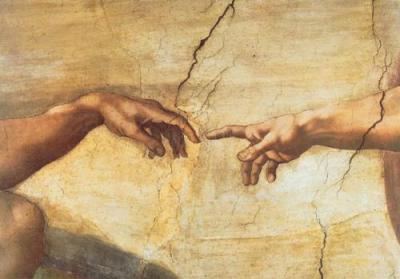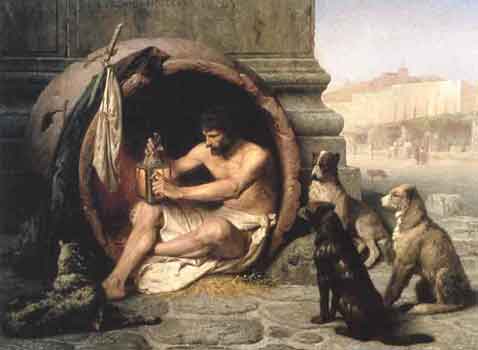This is pretty much a very straightforward classical concerto for guitar. Carulli seems to be slightly obscure, although I gather he's very well-known among classical guitarists since he wrote hosts upon hosts of works for guitar, like this one. It's really beautiful (it's difficult to go wrong with classical guitar), with some pretty technically impressive passages to boot. I think if Mozart ever wrote for guitar (which I'm pretty sure he didn't) it would sound a lot like this. Here's a nice interpretation with relatively good sound quality. Also I think it's on period instruments, but I may be mistaken. Enjoy!
Also, Carulli was pretty funny-looking, as you can see in the picture. What a silly man.
Saturday, October 30, 2010
Wednesday, October 27, 2010
The Creation of Adam
Taken from the famously provocative section of Michelangelo's fresco Sistine Chapel Ceiling, of whose design the main components are nine scenes from the Biblical story found in the Book of Genesis. Its iconic standing has elicited countless imitations from popular culture. My favorite of which is "Touched by His Noodly Appendage" by the Church of the Flying Spaghetti Monster:

("rAmen!")
Here's the perspective I like to offer on this image. It is called, ad hoc, the Creation of Adam (by God). You can see how God transfers life to Man by imposing it upon him through a touch of the Divine Hand. This serves as an overarching paradigm for interpreting the action of 'bestowing meaning' upon something that is otherwise merely matter.
However, what happens when the fresco is read not from right to left, but from left to right? The meaning inverts and becomes starkly existential: the depiction of the creation of God by Man. Man in an act not unlike cloud-watching imposes meaning and essence upon the heavens, upon what is merely space.
This is especially interesting considering the long-standing theory that the depiction of God, in combination with his red cloak and surrounding cherubim, is anatomically similar to the human brain. This would drastically redouble the notion that God exists only inside the human mind.
If anyone knows more than I do considering the religiosity of Michelangelo, please let me know. I would like to see whether there is anything to my theory that the Creation is actually meant as the greatest double entendre in the history of art (or, at least, intentionally).
Sunday, October 24, 2010
"I Knew a Woman" -- Theodore Roethke
I knew a woman, lovely in her bones,
When small birds sighed, she would sigh back at them;
Ah, when she moved, she moved more ways than one:
The shapes a bright container can contain!
Of her choice virtues only gods should speak,
Or English poets who grew up on Greek
(I'd have them sing in chorus, cheek to cheek.)
How well her wishes went! She stroked my chin,
She taught me Turn, and Counter-turn, and stand;
She taught me Touch, that undulant white skin:
I nibbled meekly from her proffered hand;
She was the sickle; I, poor I, the rake,
Coming behind her for her pretty sake
(But what prodigious mowing did we make.)
Love likes a gander, and adores a goose:
Her full lips pursed, the errant note to seize;
She played it quick, she played it light and loose;
My eyes, they dazzled at her flowing knees;
Her several parts could keep a pure repose,
Or one hip quiver with a mobile nose
(She moved in circles, and those circles moved.)
Let seed be grass, and grass turn into hay:
I'm martyr to a motion not my own;
What's freedom for? To know eternity.
I swear she cast a shadow white as stone.
But who would count eternity in days?
These old bones live to learn her wanton ways:
(I measure time by how a body sways.)
Thursday, October 21, 2010
La Beauté -- Charles Baudelaire
"I have the cold and hard perfection of
Is made of stone, the better to inspire
The dumbstruck artist's everlasting love.
Dispassionate, aloof and motionless,
A solemn sphinx, preeminent in space,
I have a snow-capped heart, a swan-like grace,
And no emotion mars my loveliness.
Poets will sacrifice their lives to brood
On all the noble poses I assume;
My every attribute and attitude
Shall play a part in that curriculum,
And I can show them what they wish to see
Through the eyes of otherworldly clarity!"
An interesting poem from Baudelaire's Fleurs du Mal, in the section "Spleen and Ideal." This poem was translated by Walter Martin. For me, it calls to mind the infamous Lisa del Giocondo, with her unremittingly nonchalant pose that has literally millions of mortals flocking to the Louvre in Paris each year just to see in person the almost mysical forces--the occult and imponderable enigmas at work behind this most uncanny woman.
Image: A fitting "Portrait of Nietzsche" by Munch (previously featured!)
Sunday, October 17, 2010
Diogenes and Cynicism
"Cynicism" of ancient Greece and Rome derives its name from the Greek word for "Dog" (κυνικός). Aristotle refers to Diogenes as "The Dog" and Diogenes seems to have accepted the nickname. Cynicism was not a "school of philosophy", but rather an "erratic succession of individuals" which can be said to have begun with the philosopher Antisthenes. Antisthenes, an admirer of Socrates, renounced refined philosphy, claiming that the average person could know all there is to know. Antisthenes was probably more conscientiously philosophical though less clever than his pupil Diogenes. Antisthenes emphasized moral self-mastery and is purported to have rejected government, property, marriage and religion. Yet while Antisthenes regarded property as a hindrance, Diogenes was not above stealing, asserting that "all things are the property of the wise."
Diogenes did little philosophizing, but sought to live an exemplary life of autonomy. He lived in a tub and is said to have derived enormous pleasure in all that he did. He said Plato's lectures were a waste of time. Plato had defined Man as a "featherless biped". Diogenes plucked a fowl and brought it into the lecture room with the words "Here is Plato's man." Consequently, "having broad nails" was added to the definition.
Insofar as Diogenes was known as "The Dog" throughout Athens, at a feast certain people would keep throwing all the bones to him as they would to a dog. Accordingly, he played a dog's trick and urinated on them. It is believed that Diogenes trampled upon Plato's carpets with the words "I trample upon the pride of Plato", who retorted, "Yes, Diogenes, with pride of another sort."
Read more about Cynicism and the escapades of Diogenes in this excellent essay by Ben Best.
Wednesday, October 13, 2010
Ode to Joy
A good piece of music reflects the soul, but a great piece of music captures its essence.
Symphony No. 9 "Ode to Joy"--adapted from a poem by the great early German Romantic writer Friedrich Schiller--is undoubtedly one of the greatest achievements of mankind--a lyrical tour de force of gorgeous, hauntingly ethereal melody which represents a pinnacle in human creativity. Brilliantly outshining some of man's shadowy mistakes and errors, this piece is evidence that greatness is achieveable; that human potentiality is limitless; that, through our minds and abilities, we can unlock amazing ideas.
I remember first hearing this in fifth grade in an elementary music class, and I was simply left awestruck. For me, it's a celebration of all things beautiful in the world, the exclamation point at the end of life's marvelous sentence.
Saturday, October 9, 2010
When I Heard the Learn'd Astronomer -- Walt Whitman

"When I heard the learn’d astronomer;
When the proofs, the figures, were ranged in columns before me;
When I was shown the charts and the diagrams, to add, divide, and measure them;
When I, sitting, heard the astronomer, where he lectured with much applause in the lecture-room,
How soon, unaccountable, I became tired and sick;
Till rising and gliding out, I wander’d off by myself,
In the mystical moist night-air, and from time to time,
Look’d up in perfect silence at the stars."
I don't ordinarily enjoy Whitman, and I'm still not exactly sure how to take this one--or how far I can extend its ostensible meaning. Is Whitman bemoaning an intellectualized approach to astronomy, or to the study of nature in general? Can I take this message to the door of Theology?--to intellectualism in general? Nevertheless, something lingers in this poem which I am sure the Transcendentalists would have eaten for breakfast, lunch and dinner.
Wednesday, October 6, 2010
Canon in D -- Pachelbel
This post is actually about a piece I really don't like. There are many reasons why I don't like it. Here's a recording to which I urge you not to listen. I have certain prejudices against pieces that are very very popular, particularly when they are so popular that they are widely-known even among people who I don't consider to appreciate music very much, as irrational as that may sound. However, when it comes to this piece, it goes beyond that. This man conveys the message very clearly. The piece is mainly just... boring, repetitive, predictable, and plenty of other similar descriptors. Also, it's sheer "prettiness." Not only this, but it is the same prettiness over and over again... 54 times (see picture). Where's the tension? Where are the climaxes? Sure, it's baroque, but even then they had some sense of musicality and the swings of emotions that would later feature far more prominently in the romantic period. And sure, there's some not-terrible counterpoint involved, but it certainly doesn't match the feats of the masters like Bach, Handel, Telemann, etc. So why is it so much more popular? Who knows, but I consider it an unfortunate circumstance, given my opinion of the work.
Sunday, October 3, 2010
Two Sculptures
Top is The Age of Bronze by Rodin. When it was exhibited, it was so realistic that Rodin was accused of casting over a living model, which he later disproved with photographic evidence. Rodin is also notably the sculptor of such works as The Kiss and The Thinker, both part of his Gates of Hell masterpiece.
Bottom left is the similar Dying Slave by Michelangelo, which I'll admit isn't as representative of him, but it's still tremendously good, like all of his work.
Anywho, the purpose of this particular post was to see if anyone derives the same satisfaction from connecting two chronologically and geographically disparate phenomena of artistic brilliance by their form.
Subscribe to:
Posts (Atom)








